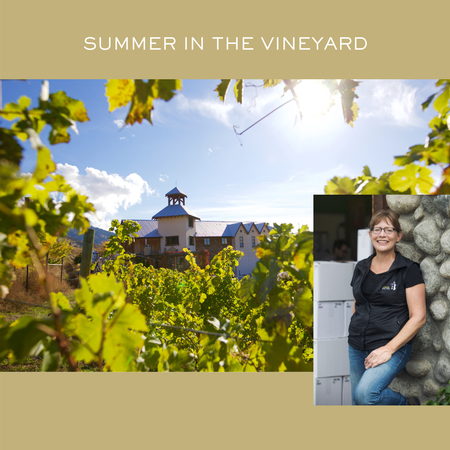What is happening in the vineyard?
Well…so much has happened since we last talked! The vines have gone from bare trunks with 2 or 3 shoots to a lush jungle of green. Bud Break occurred in the first week of May (about a week later than “normal”) pushing tiny leaves up out of the shoot at each bud. After 2-3 leaves emerge you can see what will become grape clusters appear and the miracle of nature is evident.
This year a cool wet spring favored growth of the vines, but slowed flowering so Bloom didn’t start until June 11th, about 4 days behind normal. Grapevines are self-pollinating and the flowers are fascinating. Each nascent grape within the cluster is topped by a brown cap, which pops off at flowering causing a pollen-tipped starburst to spring out—dusting the center with pollen. The pollen is viable for about 24 hours, so it is important that conditions be favorable—no hard rain, strong wind, excessive heat.
Within about a week of flowering, it’s effectiveness can be easily assessed. Berries which have been pollinated will enlarge, while those that have not, called “shot” berries, will remain hard and soon fall to the ground. Berries continue to grow, eventually filling the cluster to form Bunch closure. From this point, the vine is working, using sunlight, moisture and soil, to create the building blocks for ripening—precursors for sugar, flavour and tannins. This process lasts several weeks, through to mid-to-late August when Veraison occurs. This is when the berry starts to change colour, soften and sweeten.
The quality of the fruit and the health of the vines are ensured through good canopy management. The canopy is made up of all the green growth which arises from the canes in each growing season. This means growing just the right sized vine to provide energy to ripen the fruit with enough nutrients left to store in the root system through the winter for the start of next growing season, and no more. If the canopy is too large, energy and nutrients go into maintaining this structure rather than ripening the fruit. If the canopy is too small, there is not enough leaf to produce the sugar (by chlorophyll from sunlight) to ripen the grapes.
This balancing act is achieved through winter pruning, spring shoot thinning, cluster thinning after fruit set, a judicious watering regime, and hedging. Drip irrigation is used because it allows us to have careful control over how much water each vine receives, and does not cool the immediate microclimate as overhead irrigation can. It also means no water is wasted.
For red grapes, berry tannin ripening is ensured by leaf plucking to expose the clusters to direct sunlight well before veraison—the time when the berries start to take on colour and swell to normal size.
Weather is monitored continually and sprays are used only as necessary to prevent diseases such as powdery mildew or botrytis from taking hold. We are fully committed to the concepts of sustainable practices.
Grape growing requires constant care and attention-to-detail to ensure the highest quality fruit and healthy vines that will continue to produce this quality for years to come. At Hillside we feel this is the most critical factor in making wines of superb quality and longevity.
Harvest timing is determined by measuring the brix, or percent sugar, in the grapes and, most importantly, by taste—but more about that next time…

